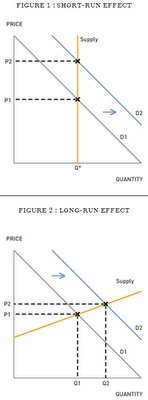Do Renewable Fuels Mean World Hunger?
by Chris Makler Sky-high oil prices and concerns over global warming have sparked a debate about renewable energy sources. One such alternative is to use biological fuels (rather than fossil fuels like oil) to power automobile cars. Willie Nelson has started selling BioWillie, a form of diesel made in part from vegetable oil. And ethanol, a form of gasoline made from corn, has begun to take off as a viable alternative to traditional gasoline in cars.
Sky-high oil prices and concerns over global warming have sparked a debate about renewable energy sources. One such alternative is to use biological fuels (rather than fossil fuels like oil) to power automobile cars. Willie Nelson has started selling BioWillie, a form of diesel made in part from vegetable oil. And ethanol, a form of gasoline made from corn, has begun to take off as a viable alternative to traditional gasoline in cars.The possibility of using corn to produce fuel is one that is obviously attractive to the nation's corn growers. But if the United States were to start using corn as a significant source of energy, would that mean that the rest of the world would have less to eat? Would poor children go starving just so yuppies could drive their SUVs? This article in the New York Times examines that possibility, but some simple economic analysis shows that these fears are unfounded.
Consider the market for corn in Iowa. Usually, demand in the market comes from animal feed producers and food processors, who make the corn into corn syrup for use in things like Danish pastries. However, this year, demand for corn increased because there are more buyers in the corn market: namely, ethanol producers.
In the short run--that is, after the corn has been harvested in a given year--the supply of corn is fixed. This is sometimes called a momentary supply curve. (You can see the fixed supply of corn in the picture in the article--it's that giant 35-foot pile in the main photo!) Therefore higher demand translates into higher prices, as is shown in Figure 1.
In the long run, though, higher prices for corn will mean that more corn will be produced. (In fact, as the article mentions, the U.S. government actually pays corn farmers NOT to farm 35 million acres of corn.) Because of these agricultural subsidies, in fact, third-world farmers are priced out of the market--so they don't plant corn. Higher demand for corn, in the long run, would mean that both U.S. producers and world producers would have more incentive to plant corn. Therefore, the long-run supply curve of corn is much more elastic (i.e., much flatter) than the momentary supply curve--so the same shift in the demand causes a smaller increase in prices, and enough corn to be planted to satisfy the need for food and fuel, as shown in Figure 2. In the long run, an increase in the demand for corn increases the amount of corn produced and consumed in the world.
1. The article quotes Lester R. Brown, an agriculture expert in Washington, D.C., and president of the Earth Policy Institute, as saying, "We're putting the supermarket in competition with the corner filling station for the output of the farm." Draw a PPF showing how much food and fuel an economy can produce with a given amount of corn. What aspect of your drawing represents the tradeoff that Mr. Brown describes? Now draw another PPF showing how much food and fuel an economy can produce if twice as much corn is planted. In what sense are short-run tradeoffs different from those in the long run?
2. Draw a supply and demand graph of the market for corn. What would happen in this diagram if the United States stopped paying corn farmers NOT to farm that 35 million acres of corn?
3. Much of the corn grown in the United States is used for animal feed. What effect would an increase in the price of Iowa corn have on the market for hamburgers?
4. What other short-run tradeoffs might be rendered irrelevant by long-term market adjustments
Labels: Elasticity, Resource Allocation, Supply and Demand



0 Comments:
Post a Comment
<< Home